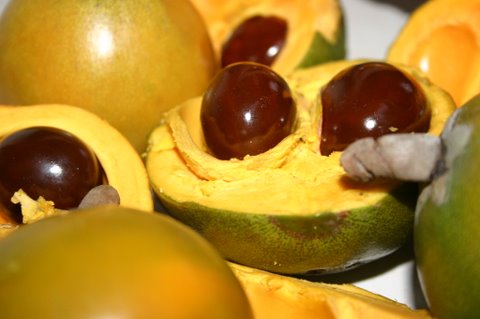Pisco and Cuisine "Lucuma Meringue"
José María Arguedas (the foremost Peruvian writer who covered
 indigenous issues in Peru), told the story of how the lúcuma, a beautiful and exquisite fruit of Peruvian origin, came to be. However, there is another tale that is very similar to the story often heard in the Central Peruvian Andes, principally in Huanuco, as told by the people of Aguamiro, as well as another version from Ancash, as told by the people of Chiquian. According to this legend, the priest and father of Andean agriculture, Huatio, appeared on Earth in the ragged form of an Indian and was hated by everyone. People even threw dirt in his face. Huatio is thought to be the craftsman of the Andes and their irrigation channels.
indigenous issues in Peru), told the story of how the lúcuma, a beautiful and exquisite fruit of Peruvian origin, came to be. However, there is another tale that is very similar to the story often heard in the Central Peruvian Andes, principally in Huanuco, as told by the people of Aguamiro, as well as another version from Ancash, as told by the people of Chiquian. According to this legend, the priest and father of Andean agriculture, Huatio, appeared on Earth in the ragged form of an Indian and was hated by everyone. People even threw dirt in his face. Huatio is thought to be the craftsman of the Andes and their irrigation channels. During that time, there was a holy woman named Lúcuma. She was very beautiful, proud, and was so contemptuous that no man would pay attention to her. The story says that while she was resting in the shade of a tree called “lugma” or “lúcuma,” Huatio appeared in the form of a beautiful bird. He caused a fruit, in which he had previously deposited his semen, from the tree to fall towards the woman. Lúcuma, when she took hold of the fruit, became pregnant, even though she had never been with a man. When her son was born, she breast-fed him. After a year, when the child began to move about, he asked the men of the village to clarify which one of them was his father.
They gathered in the skirts of the PUNCHAO (which is the ancient name of the Sun. It means light, clarity, and is a location in the department of Huanuco). Since all the men wanted to marry the goddess, they arrived in their best clothing, all according to their rank. Lúcuma asked the men to tell her son who his father was. As they all kept silent, she told her son to identify his father. He crawled to Huatio, and sat at his feet. When the child reached Huatio, who had again taken the form of a dirty and ragged Indian, the child hugged him and laughed happily. Lúcuma felt so embarrassed to have had a son by such a dirty man that she decided to leave the village and flee to the high mountains. Huatio thought that he would be able to change her mind, so he dressed himself with rich gold adornments and asked Lúcuma to look upon him. But the woman was so full of pride that she didn’t want to turn her head and look at him.
She began to walk even faster. Lúcuma reached the highest mountains and began to cry because of her misfortune. Her tears were black. It is said that her bitter tears formed an algae that is in the shape of a teardrop and is black in color. It is known today as Cushuro or Murmunta (from the Quechua word Hikunta, which means to cry bitterly), or Llullucha (from the Quechua word Llachapa, which means little man in tatters).
The Lúcuma is a beautiful fruit with a green peel, yellow pulp and a shiny brown pit. The pulp is coarse and the pit is very hard and covered with an impenetrable brown film. The Indians in the region identify the description of the fruit to be similar to the description of the proud woman. It just so happens that in Peru this fruit ripens during the months of March and April, just as the Cushuro, Murmunta or Llullucha plants ripen.
Lucuma Meringue
Chef of Cuisine - Johann Knell.
Ingredients
3 egg whites
½ cup (200 grams) granulated sugar
For the filling:
4 peeled and segmented Lucumas.
1 cup granulated sugar
1 cup water
For the Chantilly cream:
2 cups whipping cream
¼ cup powdered sugar
Preparation
Preheat the oven to 110 C (210 F). Grease and flour a large baking pan. Draw 4 circles of approximately 20 cm of diameter. Beat the egg whites with the sugar until stiff. With a pastry bag, fill the circles drawn on the pan. Bake at a low temperature for two hours, until the meringue is crisp and dry, but not golden.
Filling: In a pot over medium heat cook the water, the sugar and the lime juice until the sugar is dissolved (aprox. 10 minutes). Let cool. When the sugar is cool enough to handle, liquefy it along with the lúcuma. Strain the mixture and eliminate all impurities.
When both preparations (the meringue and the filling) are cool enough, put the meringues on top of one another and fill with the lucuma cream. Fill a pastry bag with the rest of the lucuma cream, and fit with a wide cake decorating tip.
Over a separate bowl of ice, beat the whipping cream and sugar for the Chantilly cream. The ice will make the cream more compact. Cover the side of the cake with a fine layer of Chantilly cream. Decorate the edges and the base of the cake with tiny lucuma cream balls. Serve with chocolate sauce and garnish with chocolate curls.
This dessert can also be made with chirimoya instead of the lucuma, and with a layer of manjar blanco.
Translated by Katrina Heimark













